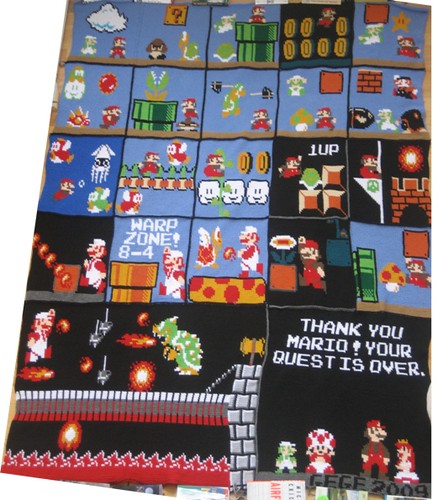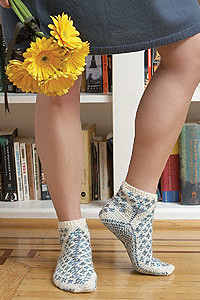I've always thought Crochet was a beautiful craft worthy of a hell of a lot more respect than what it typically receives. Unfortunately, it has taken a back seat to it's traditionally more glamorous sister, Knitting.
If fiber arts were a fairy tale, then crochet would be Cinderella. For decades, crochet was kept close to the cinders, forced to do all the housework, what with doilies, washcloths, lace edgings, and bedspreads. Occasionally, our sensible craft was allowed out, moving beyond the house to garments. But rarely was she invited to the ball. But, times have changed. Cindy Crochet isn't waiting to be invited to the ball, although she is getting more invitations.
What is old is new again
Take a look at what new old techniques have done for traditional home crafts. Tunisian crochet has transformed washcloths and afghans and now lace shawls. Kim Guzman is quite the whiz with the 16 inch hook. GeGe Crochet's Super Mario Brothers Super Blanket (above) is an amazing piece of work, at approximately 5 ' by 9'. Can you believe the detail?
"Young Man, are you sure you are trying it on the right foot?"
Crochet has left the comfort of utilitarian household goods and taken her act on the road. First, the socks. Socks are coming out of the woodwork much in the same way that the forest animals reached out to Cinderella. Check out these Troubadur Socks by Danielle Kassner (pattern published in Interweave Crochet Spring 2008). Crochet also is great for elaborate cuffs. Just be warned -- go for the fingering weight yarn -- DK and sport weight is more appropriate for crocheted socks for boots.

Great sweaters accentuate the wearer's body. Gone are the days of stiff knotted fabric better suited for washcloths and afghans. Julia Vaconsin has applied her knowledge of yarn and drape gained from her knitting to her crochet, creating beautiful garments like this Butterscotch cardigan. Julia's published designs can be found on her blog which is written in both English and French.
A dream is a wish your heart makes
Those of us who have toiled for so long at our craft, who have faithfully dreamt of being welcome at the fiber artists ball, are happy to see others appreciate crochet for what it is and what it can be. There are no limits (well just a few waiting for someone to work out the kinks). The best news is that the various crochet magazines are starting to recognize that for the craft to attract new devotees, they must
provide updated, contemporary patterns that use all weights and types of yarns.
Let's not wait for our Fairy Godmother to wave her magic wand. Climb aboard and get designing.



.jpg)



